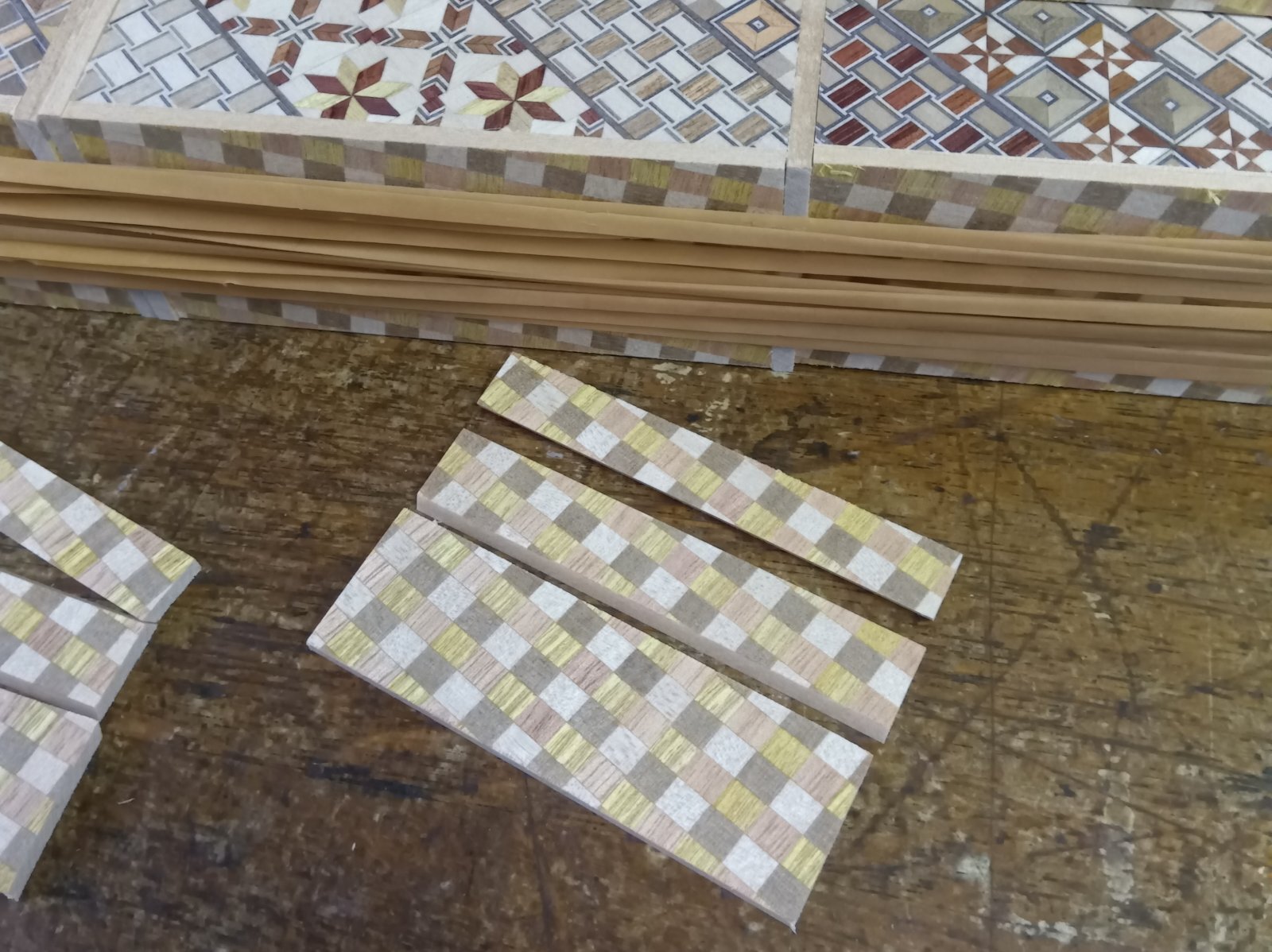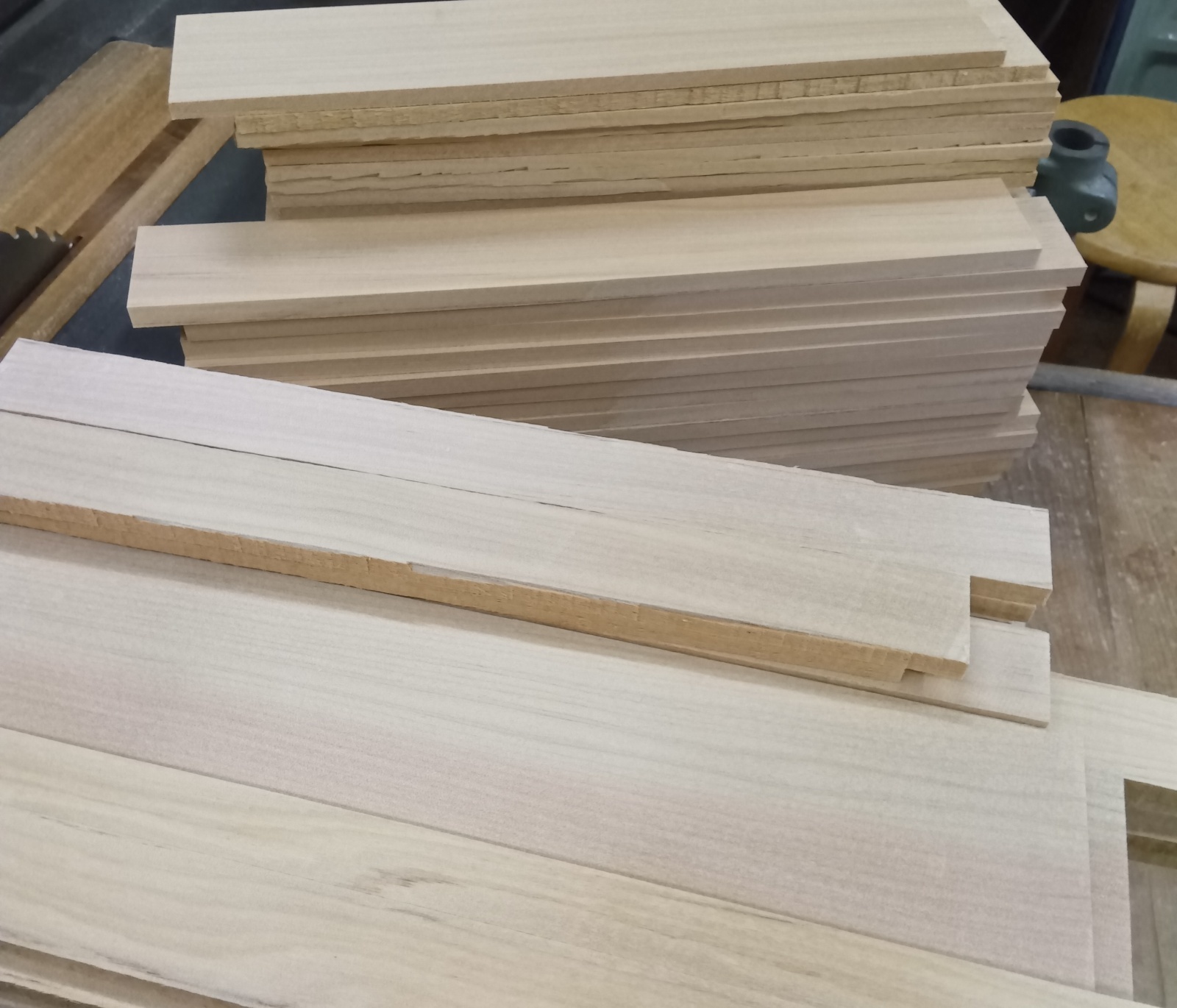Two types 27-step
Today, I started attaching the final panel of the 4-sun 27-step puzzle box (Himitsu-bako).
The final panel, as shown in the photo, is a "kannuki" panel, which is a single board divided into three sections. "Kannuki" refers to a sliding key and is one of the important mechanisms in a Himitsu-bako. It is the very first part you move when opening the box.
Attaching this panel still comes with various challenges. It remains a part of the structure that has room for improvement. This time, I slightly increased the width of the middle section of the three-part division (about 0.2 ~0.3 mm). This section is the one that actually slides, and having it a bit wider tends to make the sliding action smoother (though it’s not guaranteed). However, if it becomes too wide, the remaining two sections—especially the largest one—will have a reduced gluing surface. As I have occasionally mentioned in this blog, a large portion of this widest section is not glued, making it prone to warping and creating gaps where it meets the main body of the box. Therefore, it must be made as wide as possible. It’s quite a tricky balance to achieve...🧐
Since the final panel is attached to both sides of the box, this process takes two days. The dimensions of the "aruki(moving panels)" are slightly different on each side, so I always carefully consider which side to attach first before starting the work. This is because one side has a smaller gluing surface and is more prone to warping. Today, since the humidity was relatively low, I chose to attach the panel to the side with the narrower gluing surface, which is more likely to warp. Tomorrow, I will attach the panel to the other side.
Today, in addition to this work, I also started my next project: the production of the 5-sun 27-step puzzle box. Initially, I had planned to make a 36-step version, but in the end, I decided to produce the 27-step one again.
Of course, the 5-sun 27-step box is quite a challenging piece. While it has the same 27-step mechanism as the 4-sun version mentioned above, there are differences in the manufacturing process. Today, I prepared the materials and cut the side panels and axle panels for the structural components. This box is very popular, and I receive many requests for it. Lately, when it comes to the 5-sun size, I have been alternating between making this box and the 5-sun 10-step with drawer. The photo shows the materials for the structural components of this box—enough for about 32 pieces. All of them are made from Agathis wood, but I carefully select the best-suited pieces for each part of the structure. For example, softer wood is chosen for the "aruki" sections. Agathis wood has significant variations in texture and hardness, so selecting the right pieces is crucial.
I will continue working on these tasks tomorrow.
The final panel, as shown in the photo, is a "kannuki" panel, which is a single board divided into three sections. "Kannuki" refers to a sliding key and is one of the important mechanisms in a Himitsu-bako. It is the very first part you move when opening the box.
Attaching this panel still comes with various challenges. It remains a part of the structure that has room for improvement. This time, I slightly increased the width of the middle section of the three-part division (about 0.2 ~0.3 mm). This section is the one that actually slides, and having it a bit wider tends to make the sliding action smoother (though it’s not guaranteed). However, if it becomes too wide, the remaining two sections—especially the largest one—will have a reduced gluing surface. As I have occasionally mentioned in this blog, a large portion of this widest section is not glued, making it prone to warping and creating gaps where it meets the main body of the box. Therefore, it must be made as wide as possible. It’s quite a tricky balance to achieve...🧐
Since the final panel is attached to both sides of the box, this process takes two days. The dimensions of the "aruki(moving panels)" are slightly different on each side, so I always carefully consider which side to attach first before starting the work. This is because one side has a smaller gluing surface and is more prone to warping. Today, since the humidity was relatively low, I chose to attach the panel to the side with the narrower gluing surface, which is more likely to warp. Tomorrow, I will attach the panel to the other side.
Today, in addition to this work, I also started my next project: the production of the 5-sun 27-step puzzle box. Initially, I had planned to make a 36-step version, but in the end, I decided to produce the 27-step one again.
Of course, the 5-sun 27-step box is quite a challenging piece. While it has the same 27-step mechanism as the 4-sun version mentioned above, there are differences in the manufacturing process. Today, I prepared the materials and cut the side panels and axle panels for the structural components. This box is very popular, and I receive many requests for it. Lately, when it comes to the 5-sun size, I have been alternating between making this box and the 5-sun 10-step with drawer. The photo shows the materials for the structural components of this box—enough for about 32 pieces. All of them are made from Agathis wood, but I carefully select the best-suited pieces for each part of the structure. For example, softer wood is chosen for the "aruki" sections. Agathis wood has significant variations in texture and hardness, so selecting the right pieces is crucial.
I will continue working on these tasks tomorrow.

